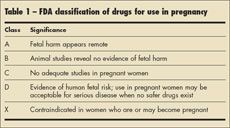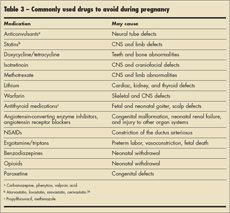Prudent Prescribing for Women of Reproductive Age
About 50% of pregnancies in the United States are unplanned.1 Thus, an awareness of which medications are safe and which are contraindicated in pregnancy is essential for good primary care-even in practices that do not include obstetrics.
Dr Schwarz is assistant professor of medicine and obstetrics, gynecology, and reproductive sciences at the University of Pittsburgh. Dr Spagnoletti is assistant professor of medicine at the University of Pittsburgh.
About 50% of pregnancies in the United States are unplanned.1 Thus, an awareness of which medications are safe and which are contraindicated in pregnancy is essential for good primary care-even in practices that do not include obstetrics.
Each year in the United States, 1 in 33 infants (3% of all newborns) are born with a physical or mental defect.2 Although the exact cause of most birth defects is not known, it is recognized that teratogenic exposures can increase rates of birth defects. US women of childbearing age receive an estimated 11.7 million prescriptions for potentially teratogenic medications each year (95% confidence interval, 11.3 to 12.1 million), 3 and about 6% of US pregnancies involve exposure to potentially teratogenic medications.4
When a medication that may be teratogenic is the most effective therapy available for a woman of reproductive age, highly effective contraception must be used. The only exceptions are instances in which the patient has clearly demonstrated an understanding of the increased risk of a birth defect and has stated her willingness to accept such risk.
SOURCES OF DRUG SAFETY INFORMATION

Pregnant women are usually excluded from randomized trials for ethical reasons. Thus, information on the safety of medications during pregnancy is provided by animal studies and postmarketing observational data. In general, more data are available for older medications.
This information has been used by the FDA to create a drug classification system based on the risk of adverse pregnancy outcomes (Table 1). FDA

drug classifications are listed in all package inserts and are included in commonly used references, such as the Tarascon Pocket Pharmacopoeia5 and ePocrates.6 More detailed information on the safety of drugs for pregnant women can be found in the resources in Table 2.
GENERAL APPROACH TO PRESCRIBING DURING PREGNANCY

A good rule of thumb is always to prescribe the lowest effective dose of the safest medication. Generally, older medications with good safety records are preferable to newer medications for which fewer data are available to demonstrate their safety.
Commonly used medications that should be avoided during pregnancy are listed in Table 3. If possible, all medications should be avoided during the first trimester, when embryogenesis occurs.
When considering prescribing a medication to a woman who is or who wants to become pregnant, thoroughly discuss the risks and benefits with her. Allow the patient to weigh the risks of untreated disease against any potential adverse effects of the medication on herself and her fetus.
RECOMMENDED MEDICATIONS FOR COMMON CONDITIONSAsthma. Up to 8% of pregnant women have asthma.7 Asthmatic pregnant women need pharmacotherapy because exacerbations have adverse effects on both mother and fetus. Most medications commonly used to treat asthma have good safety records during pregnancy.
Therefore, the management of asthma in pregnant patients is similar to its management in nonpregnant patients.
First-line agents for use during pregnancy include short-acting inhaled β2 agonists (such as albuterol), inhaled corticosteroids (such as budesonide), and long-acting inhaled β2 agonists (such as salmeterol or formoterol). Second-line agents for asthma-which are also safe for use during pregnancy-include cromolyn, theophylline, and leukotriene receptor antagonists (such as zafirlukast and montelukast). Systemic corticosteroids are generally considered safe, although some studies have shown an increased risk of prematurity and low birth weight with their use.8Viral upper respiratory tract infection. First-line therapies for nasal congestion in pregnant women include saline nasal spray, intranasal cromolyn, intranasal corticosteroids (such as beclomethasone and budesonide), and first-generation antihistamines (such as chlorpheniramine and hydroxyzine). The decongestant phenylephrine and second-generation antihistamines (such as loratadine and cetirizine) are considered second-line agents because fewer data exist to support the safety of their use during pregnancy. Avoid pseudoephedrine during the first trimester because of its possible association with fetal gastroschisis.9 Acetaminophen is safe for pregnant women and can be used for sore throat, headache, and fever. There are few data on the use of antitussive agents during pregnancy; however, dextromethorphan is generally considered safe to prescribe if cough symptoms are severe.10
Bacterial upper respiratory tract infection. Antibiotics commonly used to treat nonpregnant patients with bacterial sinusitis and bacterial pharyngitis-and considered safe for use during pregnancy-include the penicillins, cephalosporins, erythromycin, and azithromycin.11
Urinary tract infection. This affects up to 7% of all pregnant women. Both symptomatic and asymptomatic bacteriuria should be treated during pregnancy. Ampicillin is the drug of choice for enterococcal infections. Nitrofurantoin and first-generation cephalosporins, such as cefazolin, can also be safely used during pregnancy.
Antibiotics to avoid include doxycycline and tetracycline, which can cause bone malformation and tooth discoloration. Avoid sulfonamides (eg, trimethoprim/sulfamethoxazole) during the third trimester because of associated neonatal hyperbilirubinemia. Quinolones should generally not be used during pregnancy because the safety data on these agents are limited.12 Migraine. Ergotamine and the triptans are contraindicated throughout pregnancy. Ergotamine has potent oxytocic and uterine stimulating properties, and triptans are generally avoided during pregnancy because of a paucity of safety data to support their use.13 Of the remaining agents used to treat migraine, acetaminophen has the best safety record. Episodic use of ibuprofen or aspirin is probably safe, but both should be avoided during the third trimester. .-Blockers (such as metoprolol and propanolol) are safe for prophylaxis. Opiates are safe for pregnant women; however, in the third trimester their use may be associated with neonatal withdrawal.
Heartburn. As many as half of all pregnant women experience heartburn. Based on the quantity of human data on safety during pregnancy, antacids that contain calcium, aluminum, or magnesium are considered first-line agents, while H2-blockers, especially ranitidine, are considered second-line agents. If symptoms persist after these treatments have been tried, a proton pump inhibitor can be added. Lansoprazole is the best agent in this class for use during pregnancy because of its safety profile in animals and case reports of safety in human pregnancies.14 Misoprostol is contraindicated in pregnant women because of its ability to stimulate uterine contractions.14
Diabetes mellitus. Insulin is the recommended therapy for type 1, type 2, and gestational diabetes in pregnant women. However, the oral hypoglycemic agents glyburide and metformin are used in some instances.15Hypertension. As many as 8% of pregnancies are affected by hypertensive disorders. The treatment of mild to moderate chronic hypertension (140 to 169/90 to 109 mm Hg) in pregnant women is controversial. Prescribe antihypertensive medication in patients with concurrent endorgan damage or additional cardiac risk factors, as well as in those with more severe hypertension (higher than 170/110 mm Hg). Oral agents of choice include methyldopa, labetalol, and metoprolol. Parenteral drugs of choice include labetalol and hydralazine. Angiotensin-converting enzyme inhibitors and angiotensin receptor blockers are contraindicated throughout pregnancy. Use of these agents during the first trimester has been associated with congenital malformation,16 and their use during the second and third trimesters has been associated with fetal and neonatal injury.17Thyroid disorders. If left untreated during pregnancy, hypothyroidism can result in mental retardation of offspring.18 Levothyroxine is safe for use in pregnancy.19 Hyperthyroidism during pregnancy is usually managed by specialists.
Depression and anxiety. The treatment of depression and anxiety during pregnancy is controversial. Third-trimester use of various antidepressants- tricyclic antidepressants (such as amitriptyline), selective serotonin reuptake inhibitors (SSRIs) (such as fluoxetine, citalopram, and sertraline), and the serotonin norepinephrine reuptake inhibitor venlafaxine-may cause neonatal withdrawal or toxicity syndrome. However, such symptoms in a newborn are usually benign and self-limited.20
recent study found an association between persistent pulmonary hypertension of the newborn and maternal use of SSRIs after 20 weeks’ gestation.21 Other data have raised the possibility of an increased risk of congenital malformation and cardiovascular malformation with firsttrimester exposure to paroxetine, leading the FDA to place this medication in class “D.”22 Otherwise, antidepressants have not been associated with increased risk of congenital malformation. Benzodiazepines have been shown to cross the placenta and, if used in late pregnancy, to increase risk of neonatal withdrawal.
On the other hand, depression or anxiety that is not treated during pregnancy can have adverse effects on both mother and fetus. Thus, both the risks and benefits of antidepressant therapy must be weighed in a pregnant patient.23,24
References:
REFERENCES:
1.
Finer LB, Henshaw SK. Disparities in rates of unintendedpregnancy in the United States, 1994 and2001. Perspect
Sex Reprod Health.
2006;38:90-96.
2.
Centers for Disease Control and Prevention. BirthDefects: Frequently Asked Questions. March 11, 2009.
www.cdc.gov/ncbddd/bd/faq1.htm#
chanceofBD. Accessed March 25, 2009.
3.
Schwarz E, Maselli J, Norton M, Gonzales R.Prescription of teratogenic medications in UnitedStates ambulatory practices.
Am J Med.
2005;118:1240-1249.
4.
Andrade SE, Gurwitz JH, Davis RL, et al. Prescriptiondrug use in pregnancy.
Am J Obstet Gynecol.
2004;191:398-407.
5.
Green SM.
Tarascon Pocket Pharmacopoeia.
Loma Linda, Calif: Tarascon Publishing; 2004.
6.
ePocrates. San Mateo, Calif: ePocrates, Inc; 2004.http://www.epocrates.com.
7.
Kwon H. Asthma prevalence among pregnantand childbearing-aged women in the United States:estimates from national health surveys.
Ann Epidemiol.
2003;13:317-324.
8.
National Asthma Education and Prevention Program.Working Group Report on Managing AsthmaSymptoms During Pregnancy: Recommendations forPharmacologic Treatment-Update 2004.
http://www.nhlbi.nih.gov/health/prof/lung/asthma/
astpreg/astpreg_full.pdf. Accessed March 25, 2009.
9.
Gilbert C, Mazzotta P, Loebstein R, Koren G. Fetalsafety of drugs used in the treatment of allergicrhinitis: a critical review.
Drug Saf.
2005;28:707-719.
10.
Einarson A, Lyszkiewicz D, Koren G. The safetyof dextromethorphan in pregnancy: results of acontrolled study.
Chest.
2001;119:466-469.
11.
Duff P. Antibiotic selection in obstetric patients.
Infect Dis Clin North Am.
1997;11:1-12.
12.
Dashe JS, Gilstrap LC. Antibiotic use in pregnancy.
Obstet Gynecol Clin North Am.
1997;24:617-629.
13.
Pfaffenrath V, Rehm M. Migraine in pregnancy:what are the safest treatment options?
Drug Saf.
1998;19:383-388.
14.
Richter JE. Gastroesophageal reflux diseaseduring pregnancy.
Gastroenterol Clin North Am.
2003;32:235-261.
15.
ACOG Practice Bulletin. Clinical ManagementGuidelines for Obstetrician-Gynecologists. No. 60.Pregestational diabetes mellitus.
Obstet Gynecol.
2005;105:675-685.
16.
Cooper WO, Hernandez-Diaz S, Arbogast PG,et al. Major congenital malformation after firsttrimesterexposure to ACE inhibitors.
N Engl J Med.
2006;354:2443-2451.
17.
National High Blood Pressure Education ProgramWorking Group on High Blood Pressure inPregnancy. Report of the National High Blood PressureEducation Program Working Group on highblood pressure in pregnancy.
Am J Obstet Gynecol.
2000;183:S1-S22.
18.
Haddow J, Palomaki GE, Allan WC, et al. Maternalthyroid deficiency during pregnancy and subsequentneuropsychological development of thechild.
N Engl J Med.
1999;341:549-555.
19.
ACOG Practice Bulletin. Clinical ManagementGuidelines for Obstetrician-Gynecologists. No. 37.(Replaces Practice Bulletin No. 32.) Thyroid diseasein pregnancy.
Obstet Gynecol.
2002;100:387-396.
20.
Moses-Kolko EL, Bogen D, Perel J, et al.Neonatal signs after late in utero exposure to serotoninreuptake inhibitors.
JAMA.
2005;293:2372-2383.
21.
Chambers CD, Castilla EE, Orioli I, Jones KL.Selective serotonin-reuptake inhibitors and risk ofpersistent pulmonary hypertension of the newborn.
N Engl J Med.
2006;354:579-587.
22.
Cole JA, Ephross SA, Cosmatos IS, Walker AM.Paroxetine in the first trimester of pregnancy andthe prevalence of congenital malformations.
PharmacoepidemiolDrug Saf.
2007;16:1075-1085.
23.
Orr ST, Miller CA. Maternal depressive symptomsand the risk of poor pregnancy outcome: reviewof the literature and preliminary findings.
Epidemiol Rev.
1995;171:165-171.
24.
Lundy BL, Jones NA, Field T, et al. Prenataldepression effects on neonates.
Infant Behav Dev.
1999;22:119-129.
25.
Briggs GG, Freeman RK, Yaffe SJ.
Drugs inPregnancy and Lactation: A Reference Guide to Fetaland Neonatal Risk.
7th ed. New York: LippincottWilliams and Wilkins; 2005.
26.
Edison RJ, Muenke M. Central nervous systemand limb anomalies in case reports of first-trimesterstatin exposure.
N Engl J Med.
2004;350:1579-1582.